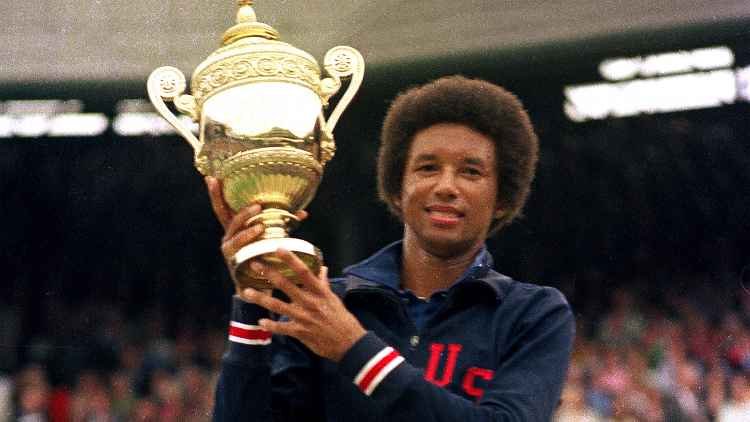Headline:
Remembering Arthur Ashe’s Historic 1975 Wimbledon Triumph: A Champion On and Off the Court…see more…
On July 5, 1975, Arthur Ashe etched his name into the annals of sports history by defeating Jimmy Connors in the Wimbledon men’s singles final. In doing so, he became the first—and still the only—Black man to win the prestigious tournament. Nearly 50 years later, Ashe’s 1975 Wimbledon victory remains a defining moment in tennis, civil rights, and global sport.
Ashe’s win was more than a tennis match—it was a masterclass in strategy, composure, and quiet rebellion. Facing Connors, the world No. 1 and heavy favorite known for his fierce power and aggressive style, Ashe approached the match not with brute force but with intellectual precision. Employing a mix of off-pace shots, well-timed net rushes, and clever tactics, Ashe neutralized Connors’ strengths and outmaneuvered him mentally and physically.
The final score—6–1, 6–1, 5–7, 6–4—stunned the tennis world. The 31-year-old Ashe, considered past his prime and a clear underdog, had outclassed a 22-year-old Connors at the peak of his dominance. But the upset went far beyond the scoreline. Ashe’s triumph symbolized grace under pressure and the power of intellect in sport. It also marked a milestone in racial progress in a game long dominated by white athletes and institutions.
Born and raised in segregated Richmond, Virginia, Ashe had already shattered barriers. In 1968, he became the first Black man to win the US Open. He followed that with the 1970 Australian Open title, but Wimbledon had always eluded him. Winning it on Centre Court, tennis’s most hallowed ground, elevated his legacy—and provided a global platform for his activism.
Unlike many athletes of his era, Ashe was a statesman of the sport. He didn’t wear his politics on his sleeve, but he was unflinching in his principles. He spoke out against apartheid in South Africa and pushed for visa denials to that country’s segregated regime. He was a vocal critic of racism, poverty, and injustice in the U.S., but always through a lens of diplomacy and thoughtful advocacy.
His Wimbledon victory was the apex of his playing career, but Ashe’s influence only grew after he retired in 1980 due to heart complications. He became a writer, speaker, and tireless advocate for humanitarian causes. In 1983, Ashe contracted HIV from a blood transfusion during heart surgery—a diagnosis he kept private for years to protect his family and maintain dignity.
In 1992, Ashe went public with his illness, using his final years to raise awareness about HIV/AIDS and combat the stigma surrounding it. He established the Arthur Ashe Foundation for the Defeat of AIDS and continued to speak out on human rights until his death in 1993 at the age of 49.
Wimbledon honored Ashe’s memory in 1993 with a moment of silence on Centre Court, and in 1997, the U.S. Open named its main stadium after him—Arthur Ashe Stadium—cementing his legacy as one of the sport’s greats.
Ashe’s 1975 win is often cited by historians and tennis legends alike as one of the most significant moments in sports history—not simply because of who he beat, but because of what he represented. It was a victory for dignity over arrogance, planning over brute force, and quiet confidence over showmanship.
Reflecting on that match, tennis analyst and former pro Patrick McEnroe once said, “It wasn’t just that Ashe beat Connors—it’s how he did it. He out-thought him, outplayed him, and showed the world that elegance and brains could triumph in a sport increasingly defined by power.”
Ashe had studied Connors carefully. In the days leading up to the final, he conferred with his coaches and fellow players like Charlie Pasarell and Dennis Ralston, devising a strategy that would dismantle Connors’ strengths. He served wide, sliced deep, and avoided rallying to Connors’ lethal two-handed backhand. He disrupted the rhythm and controlled the pace, forcing Connors into uncharacteristic errors.
“I wanted to break his rhythm, get into his head,” Ashe said later in interviews. “I knew I couldn’t go toe-to-toe with him physically. So I had to be smarter.”
He was. The first two sets took just 46 minutes. Ashe’s precision and tactical brilliance stunned Connors and the Centre Court crowd. Though Connors fought back to win the third set, Ashe regained control in the fourth, sealing the win with a powerful serve and an understated fist pump.
In a sport where emotion often spills over, Ashe remained calm throughout, his expression serene even as he made history. He didn’t fall to his knees or roar in triumph. Instead, he walked to the net, shook Connors’ hand, and raised his racket lightly in acknowledgment. That image—a composed, victorious Ashe—is etched into the collective memory of tennis.
Today, as conversations around representation, activism, and inclusion continue in sports, Arthur Ashe’s legacy resonates stronger than ever. Players like Serena Williams, Coco Gauff, Frances Tiafoe, and Naomi Osaka stand on the foundation Ashe helped build. His blend of excellence and advocacy set a precedent that many athletes now follow.
Every Wimbledon since 1975 has included a quiet nod to Ashe—whether in commentary, video montages, or reflections on diversity in tennis. But perhaps the greatest tribute is the continued inspiration he provides to athletes and fans across generations.
As tennis evolves, with faster rackets and younger champions, Ashe’s Wimbledon victory endures—not as a relic of the past, but as a timeless lesson in courage, intellect, and grace.
He wasn’t just a Wimbledon champion. He was the Wimbledon champion the worl
d needed in 1975—and still reveres today.



